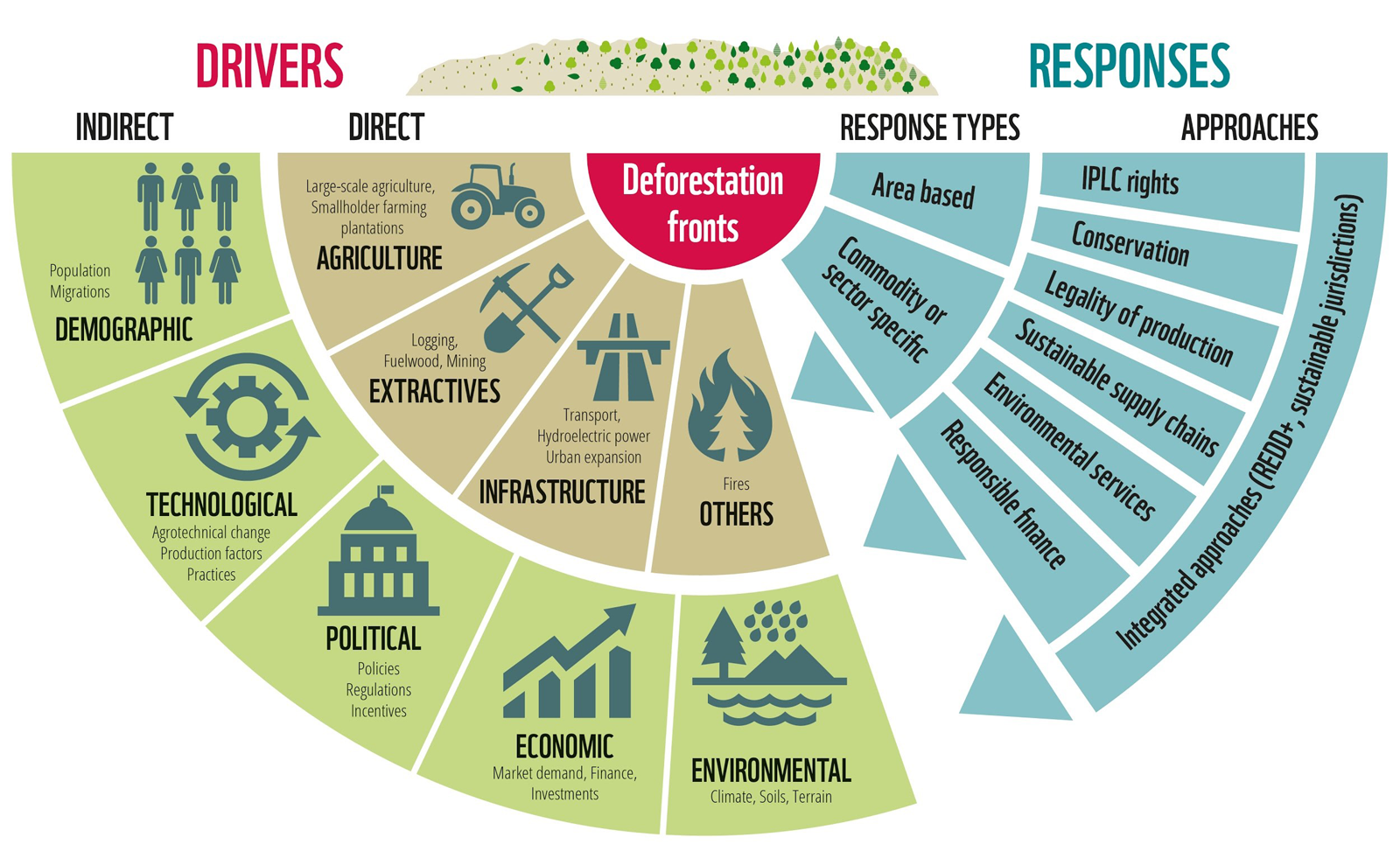MARC PALAHI
Circular Bioeconomy:
Circular economy is the economic framework that focuses on minimizing waste and creating a cycle of disassembly, reuse. Bioeconomy is the concept that focuses on the use of bio-resources as a substitute for fossil-based, non-renewable and non-biodegradable material.
Circular Bioeconomy is a fusion of the two concepts and can be defined as a holistic economic framework that keeps nature as the center of economy by responsible provision of ecosystem services through sustainable management of biological resources. Within the framework, it cater to various sectors including land use, food production, healthcare, industrial systems and sustainable urban development through use of renewable natural capital. The framework supports innovative and sustainable solutions that cater to long term well being of both the ecosystem and the human societies.
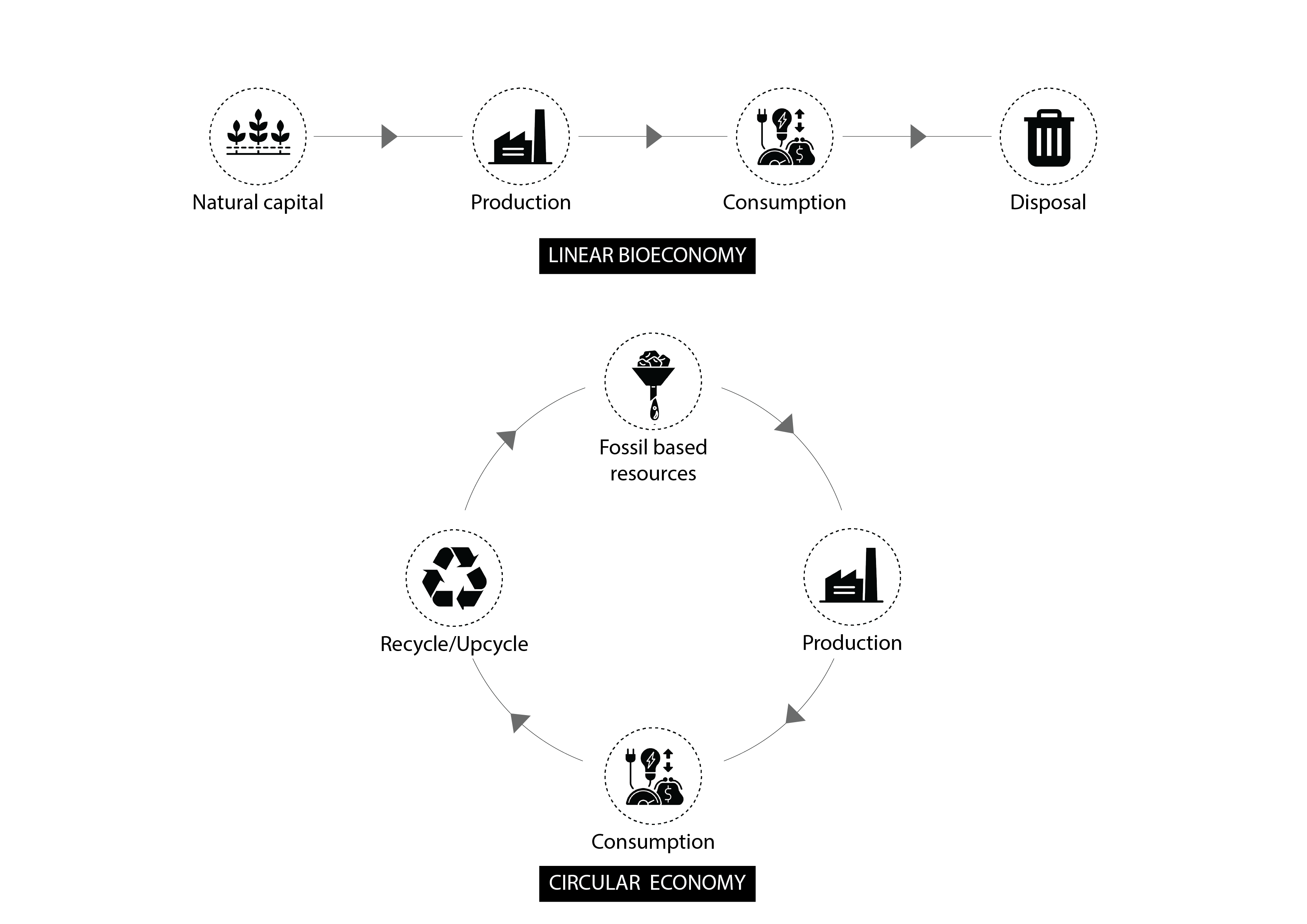
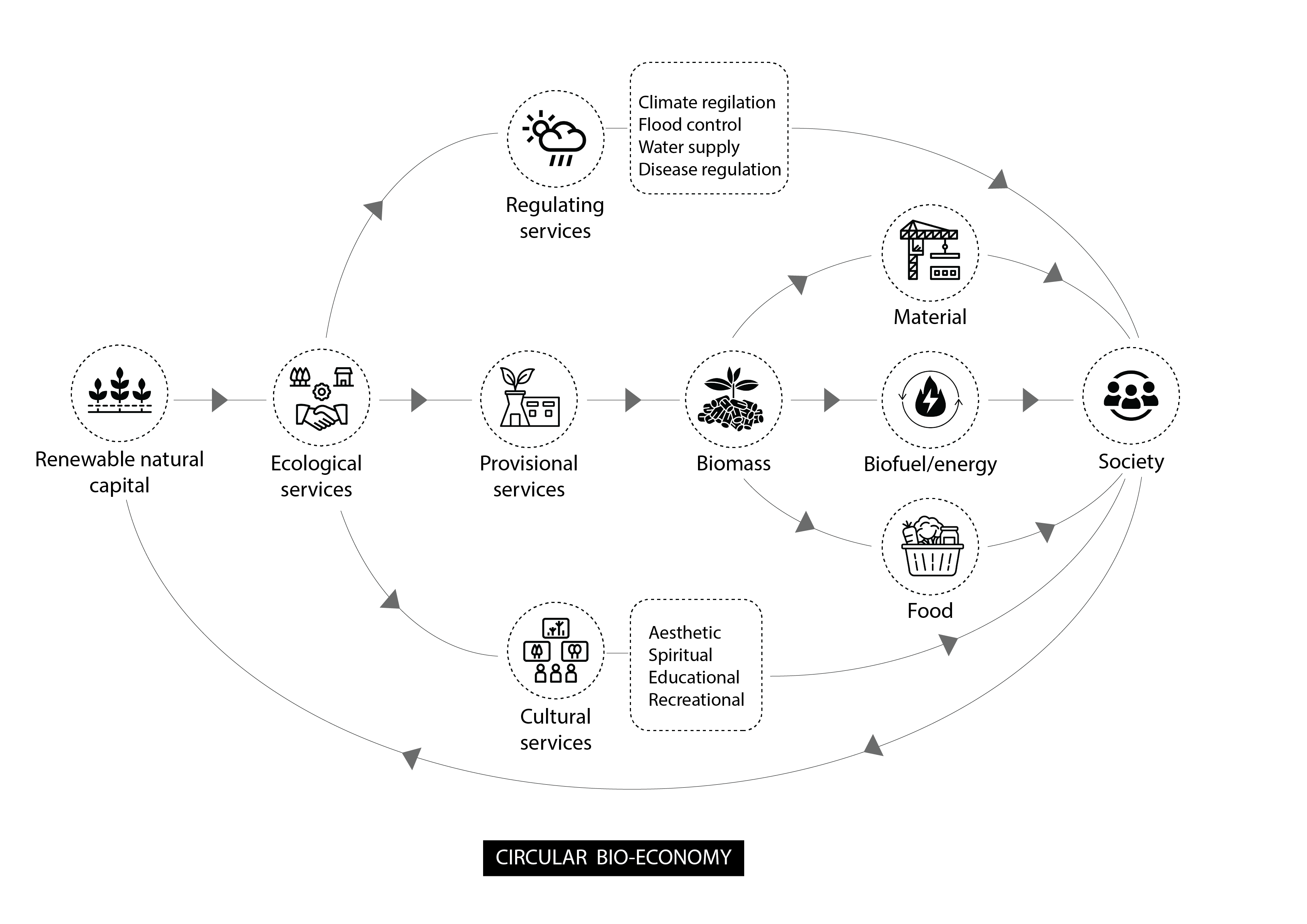
Examples:
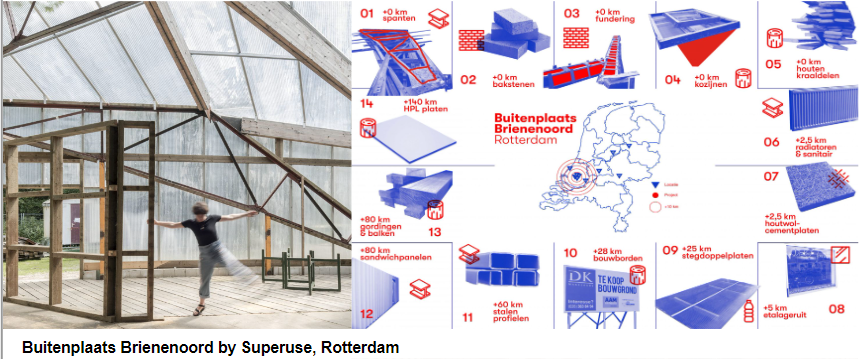
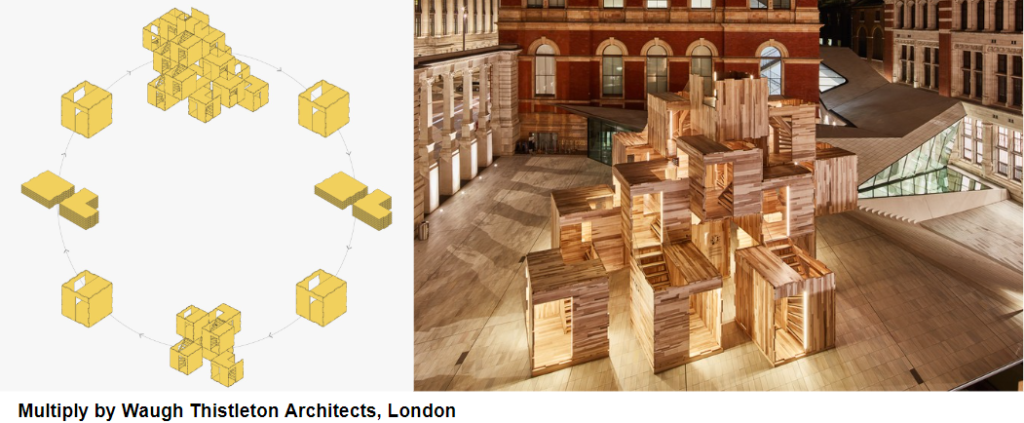
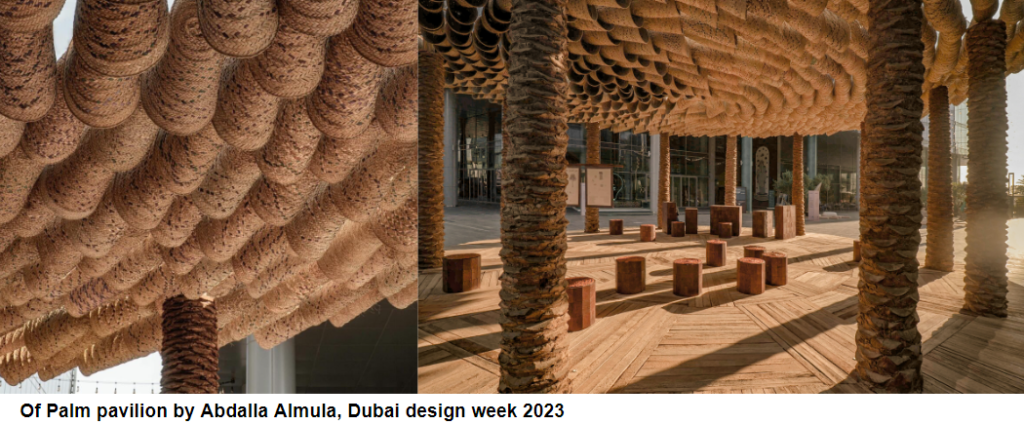
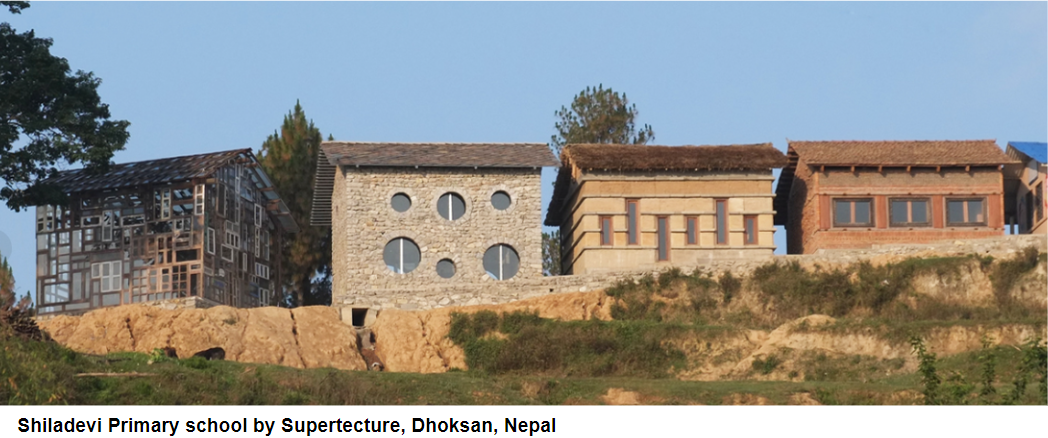
Urban Forest
An urban forest refers to a grouping of trees or a forest that thrives within the confines of a city, town, or suburb. In a broader context, it encompasses all forms of woody plant vegetation flourishing in and around human settlements. It is an intervention that aims to integrate nature into the urban fabric, blurring the traditional dichotomy between cities and natural environments that emerged due to urban development, industrialization, and rural-to-urban migration. The urban forests can vary in scale and can be in the form of individual trees in private areas, street trees, green urban parks and other green infrastructures. The central goal of urban forests is to ensure that a significant portion of the urban population gains better access to natural elements and environments and the associated benefits like Noise dampening, Water source protection, Soil protection, Energy cost reduction, Air quality improvement and favorable microclimate generation.
Various initiatives and principles exemplify the commitment to urban forest development, such as New York’s Plan NYC: 2030, striving to ensure a green area within a 10-minute walk for every resident. Cecil Konijnendijk’s 3-30-300 Rule advocates for three trees per home, a 30% tree cover in neighborhoods, and access to a green area within 300 meters. The Cities4forests alliance focuses on Inner, Nearby, and Faraway forests, emphasizing the importance of local green spaces, connecting with nearby natural areas, and recognizing the global impact of more distant forests. Together, these initiatives underscore the importance of integrating nature into urban planning for improved accessibility, environmental sustainability, and the overall well-being of urban communities.
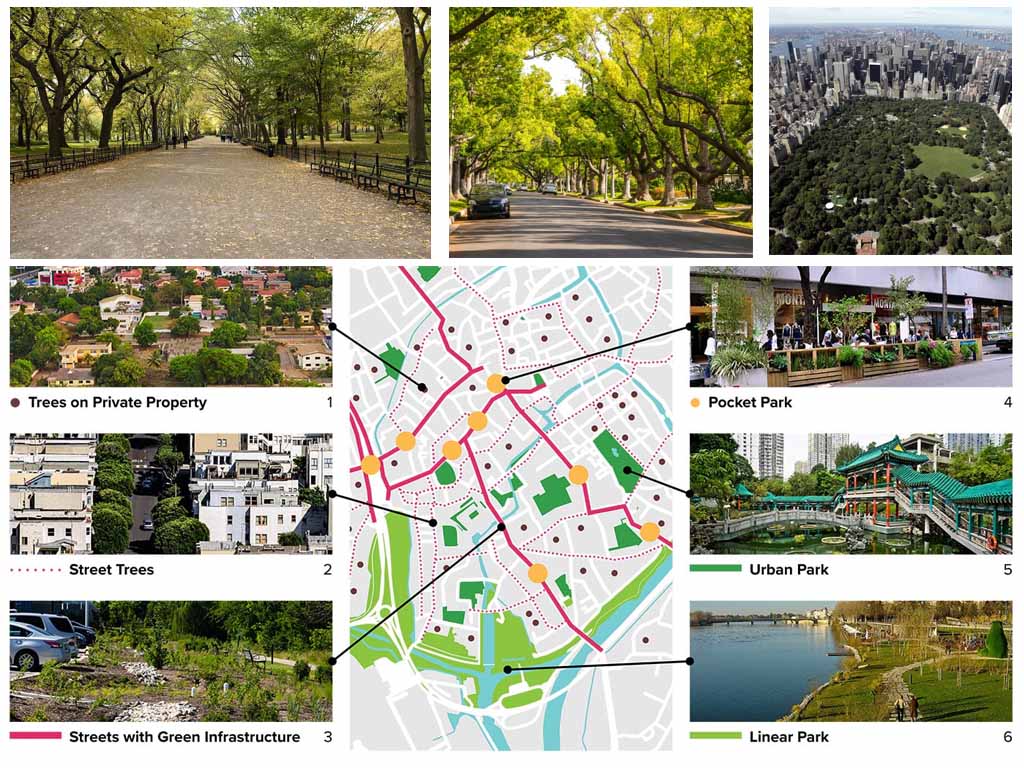
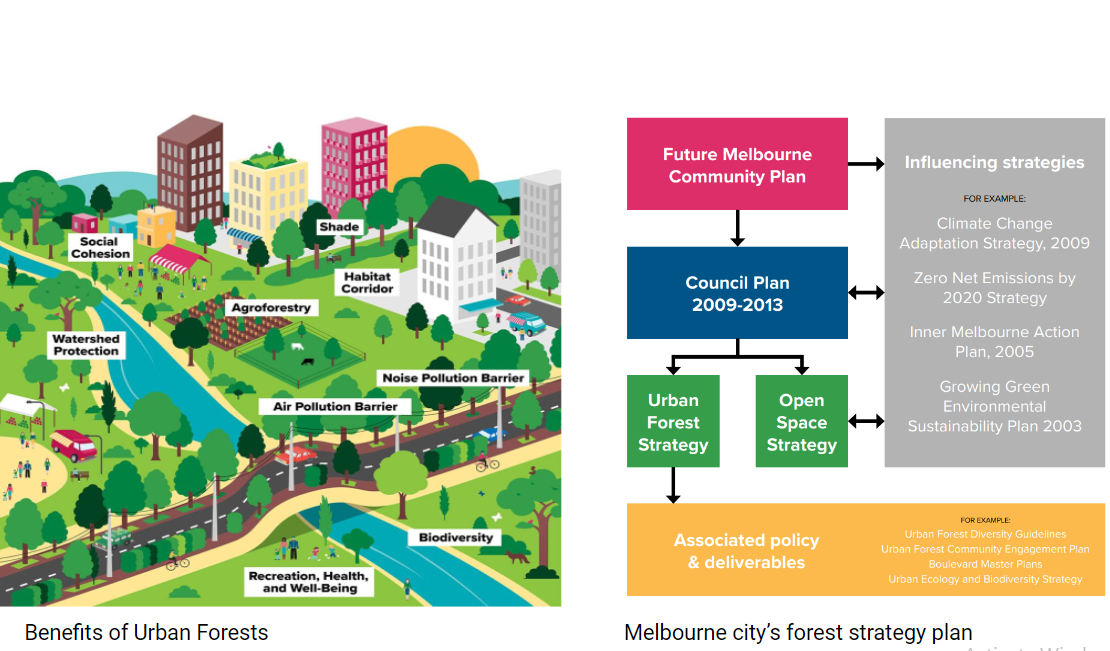
The City of Melbourne has devised an Urban Forest Strategy Plan to bolster resilience against drought, heat, and extreme weather, emphasizing six strategies such as increasing canopy cover, enhancing tree diversity, promoting tree health, improving soil moisture, safeguarding urban biodiversity, and engaging the community.
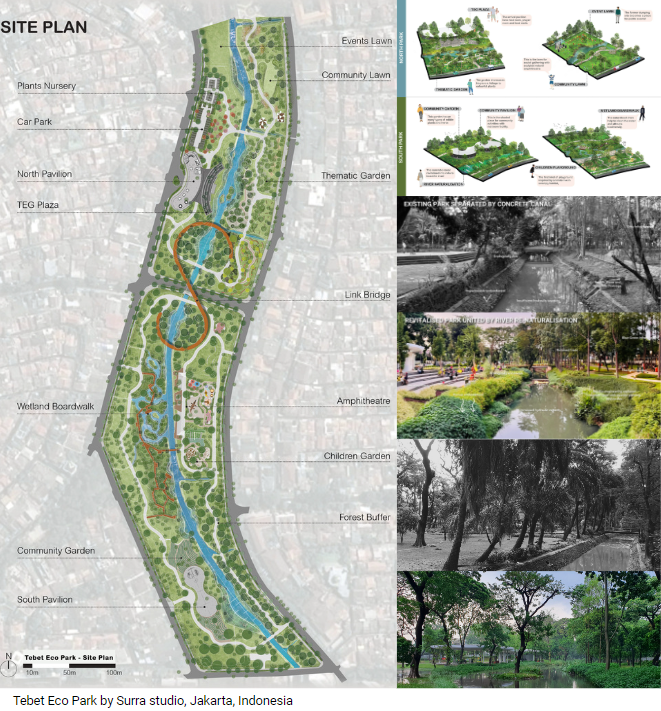
Tebet Eco Park in Jakarta exemplifies urban forest renaturalization, transforming an aging public space into a vibrant, resilient ecosystem. Through strategic tree conservation, blue-green infrastructure, and revitalized waterways, the project seamlessly integrates ecological landscapes, fostering community well-being and creating a model for urban forest regeneration.
Sustainable Forests:
Sustainable forestry is a comprehensive approach to forest management that focuses on sustainable sourcing of biomaterials and ecological services from the forest and simultaneously aiming to maintain the health and diversity of forest ecosystems. It also addresses climate change by enhancing the role of forests to increase carbon sequestration and serving as source for substitute material of carbon intensive products. IN a changing world that will grow more dependant on biomaterials sourced from the forests, the concept also includes regulating harvest cycles by keeping the bioresource stock in the forest high enough for continued growth.
The three fundamental adaptation strategies for sustainable forestry involve the conservation of existing forest structures, assuming minimal adverse effects from climate change. Passive adaptation relies on natural processes like succession and species migration to enable the forest to adjust without direct intervention. Active adaptation, on the other hand, takes proactive measures, such as introducing climate-resilient species and adjusting silvicultural practices, to actively respond to and mitigate the impacts of climate change on forestry, maintaining or enhancing the forest’s adaptive capacity.
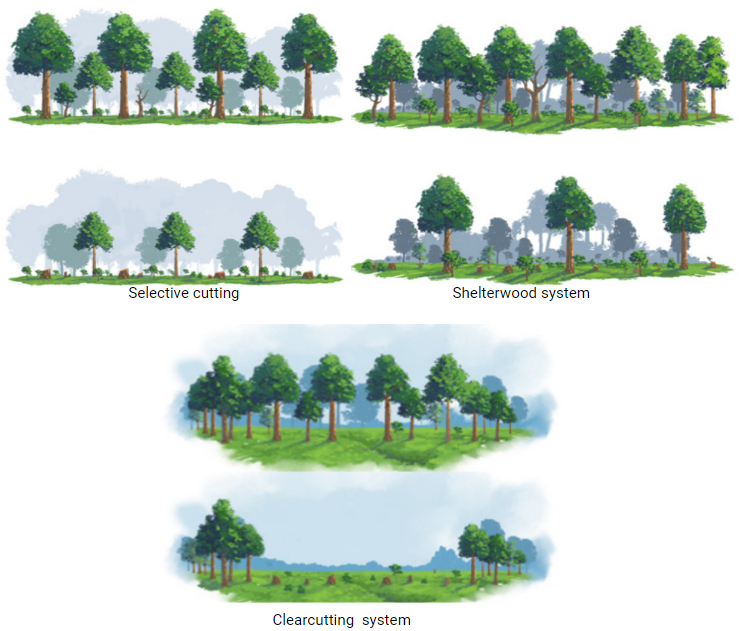
Some types of sustainable management practices: Selective cutting involves the targeted removal of individual trees to sustainably harvest timber while preserving forest health and biodiversity. The shelterwood system employs a phased approach, gradually removing mature trees in blocks of forests to encourage natural regeneration and maintain a forest canopy. Clearcutting, although initially disruptive, is a controlled method where all trees are harvested from a specific area to promote the growth of shade-intolerant species and create habitat diversity, often followed by reforestation efforts. These sustainable forest management systems are selected based on ecological goals, forest type, and the need to balance economic benefits with environmental conservation for the long-term well-being of forests.
Examples:
In the 1970s, Nepal faced an environmental crisis marked by the degradation of its hillside forests due to factors like livestock grazing and fuelwood harvesting, leading to heightened issues of flooding and landslides. Recognizing the urgency, the government reevaluated its forest management practices in the 1980s and 1990s, culminating in a pivotal forestry act in 1993. This legislation empowered forest rangers to transfer national forests to community forest groups. Recent NASA-funded research reveals that this shift to community-led management resulted in a remarkable near-doubling of forest cover in Nepal. The maps depicting forest cover in 1992 and 2016 demonstrate a significant increase, from 26 percent to 45 percent, showcasing the success of this progressive forestry policy. Presently, more than 22,000 community-forest user groups manage 34% of Nepal’s forests, highlighting the positive impact of decentralized, community-based forest management.
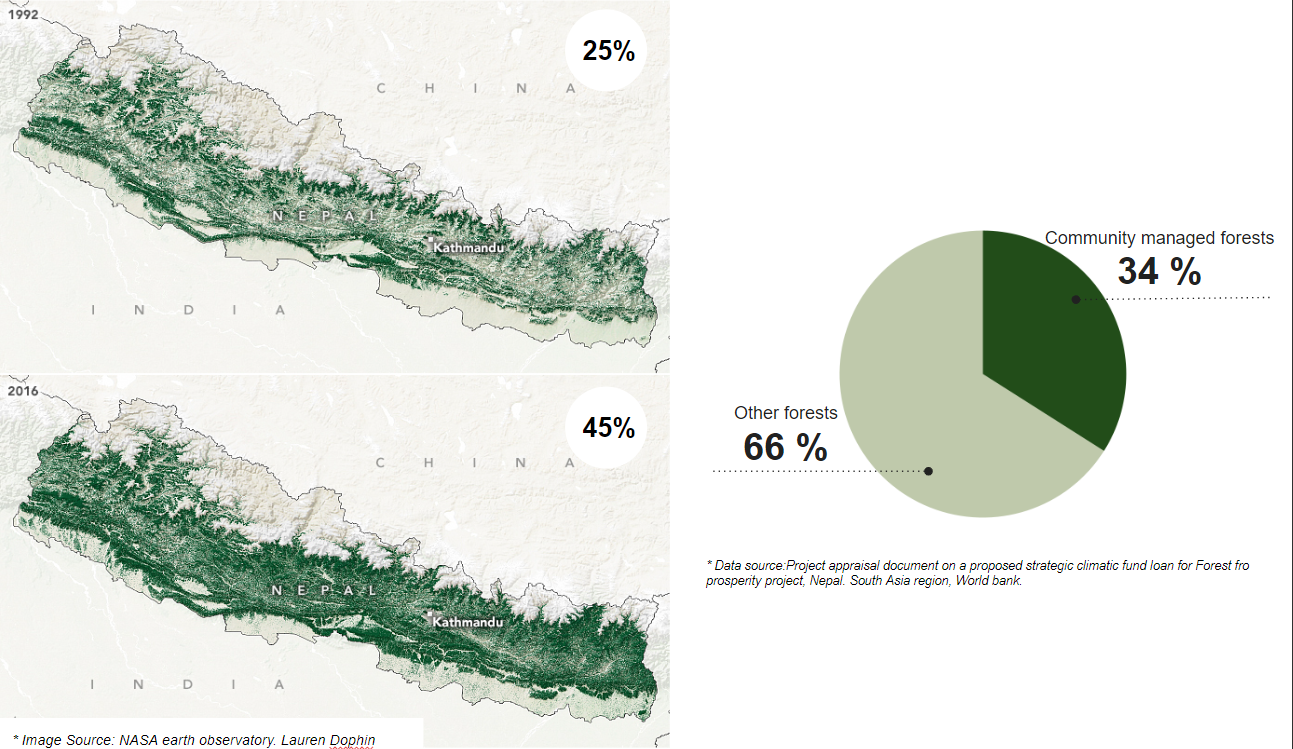
Certifications:
The Forest Stewardship Council (FSC) is a global non-profit organization founded in 1993, dedicated to advocating responsible management of the world’s forests through timber certification. Employing a market-based approach to international environmental policy, the FSC aims to foster environmentally appropriate, socially beneficial, and economically viable forest management globally. The organization has articulated its mission through a global strategy, outlining goals such as advancing responsible forest management, ensuring equitable access to FSC system benefits, maintaining integrity and transparency, creating business value for FSC-certified products, and strengthening the global network. These objectives are implemented through six program areas covering forests, chain of custody, social policy, monitoring and evaluation, quality assurance, and ecosystem services. FSC International establishes the framework for developing and maintaining international, national, and sub-national standards, emphasizing transparency, independence, and participatory processes in policy and standard development.

1.Image by: Tom Klucker
Crook, L., & Crook, L. (2022, April 6). Precht creates four cartoonish “treehouses” for Austrian restaurant. 2. Image by Rebecca Noakes Lindsay, C., & Lindsay, C. (2022, April 4) 3. Image by KIE Abdel, H. (2022, December 22). Microlibrary Warak Kayu / SHAU Indonesia. ArchDaily. 4. Image by Jack Hobhouse. Frearson, A., & Frearson, A. (2019, December 5).
Bioregion:
A bioregion is a geographically and ecologically defined area characterized by distinct patterns of flora, fauna, climate, and terrain. The boundaries of a bioregion are typically based on ecological factors rather than political or administrative divisions, emphasizing the interconnectedness of natural systems within that specific geographic space. The concept of a bioregion recognizes the importance of understanding and preserving the unique ecological characteristics of a given area for sustainable and context-specific environmental management. Bioregions are encompassed within their overarching realms, signifying that each realm comprises a specific and limited number of bioregions. Additionally, these bioregions can be further grouped into sub-realms, providing a hierarchical structure that aids in organizing and understanding the ecological diversity within a given geographic context.
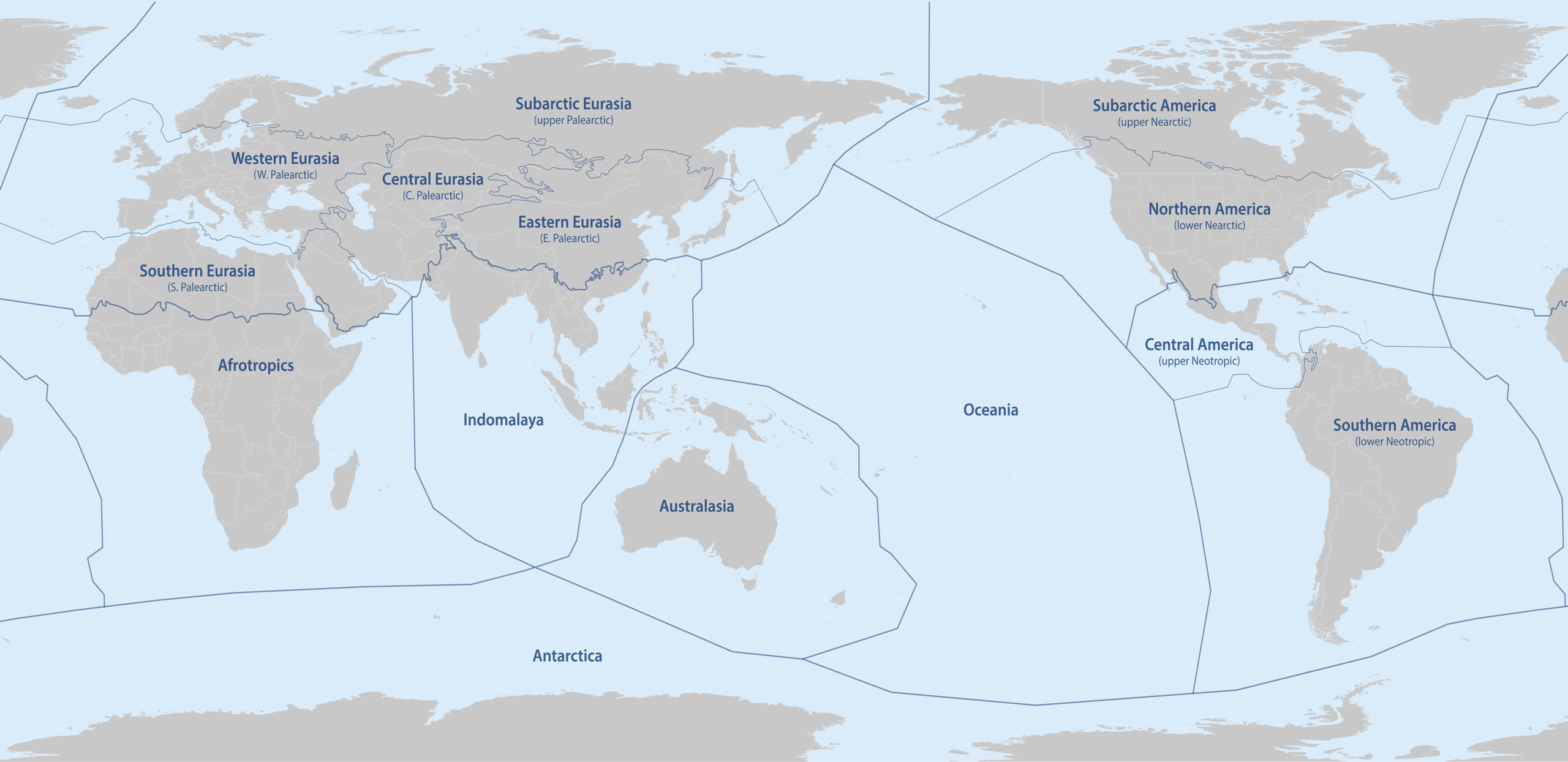
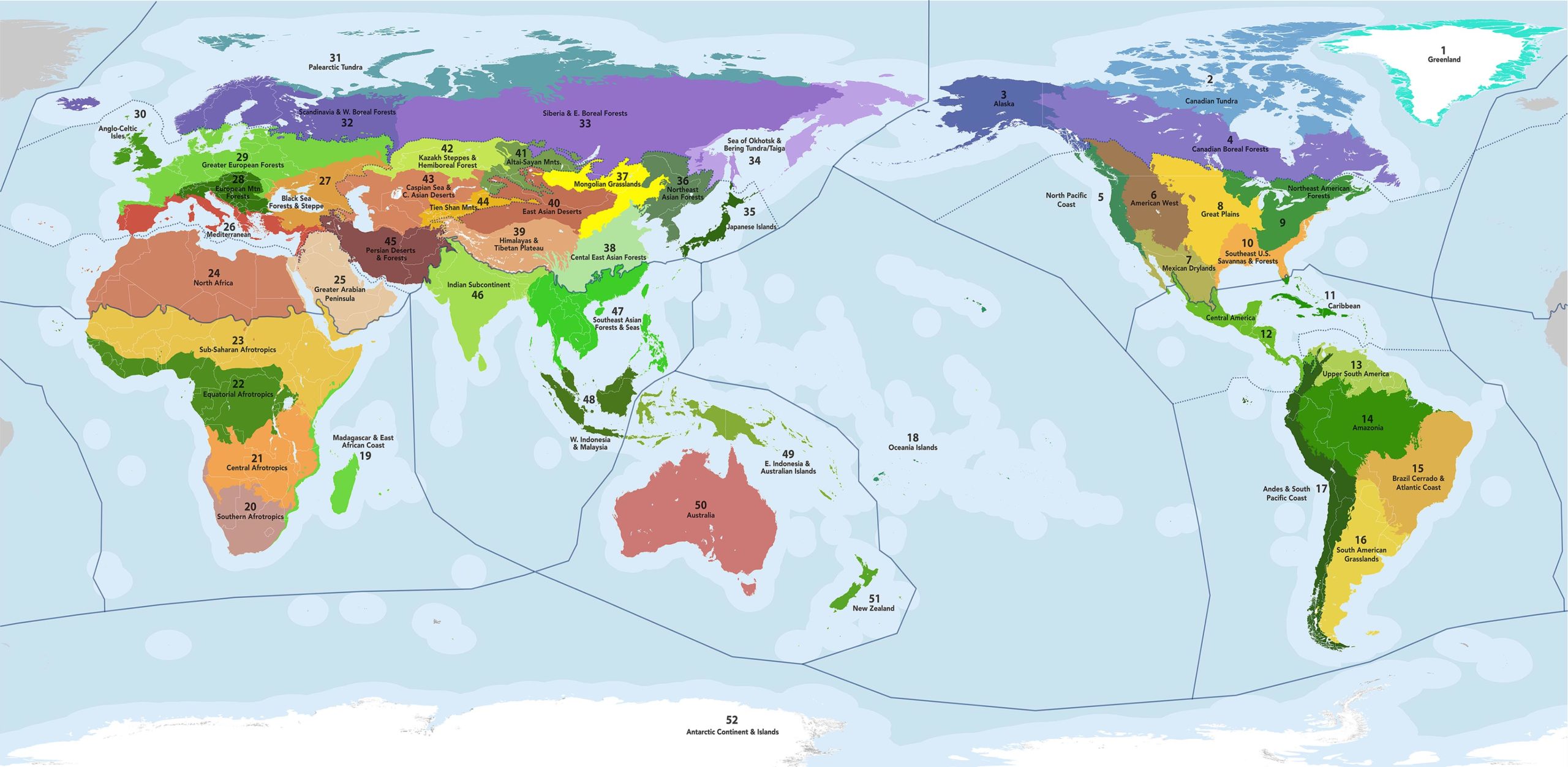
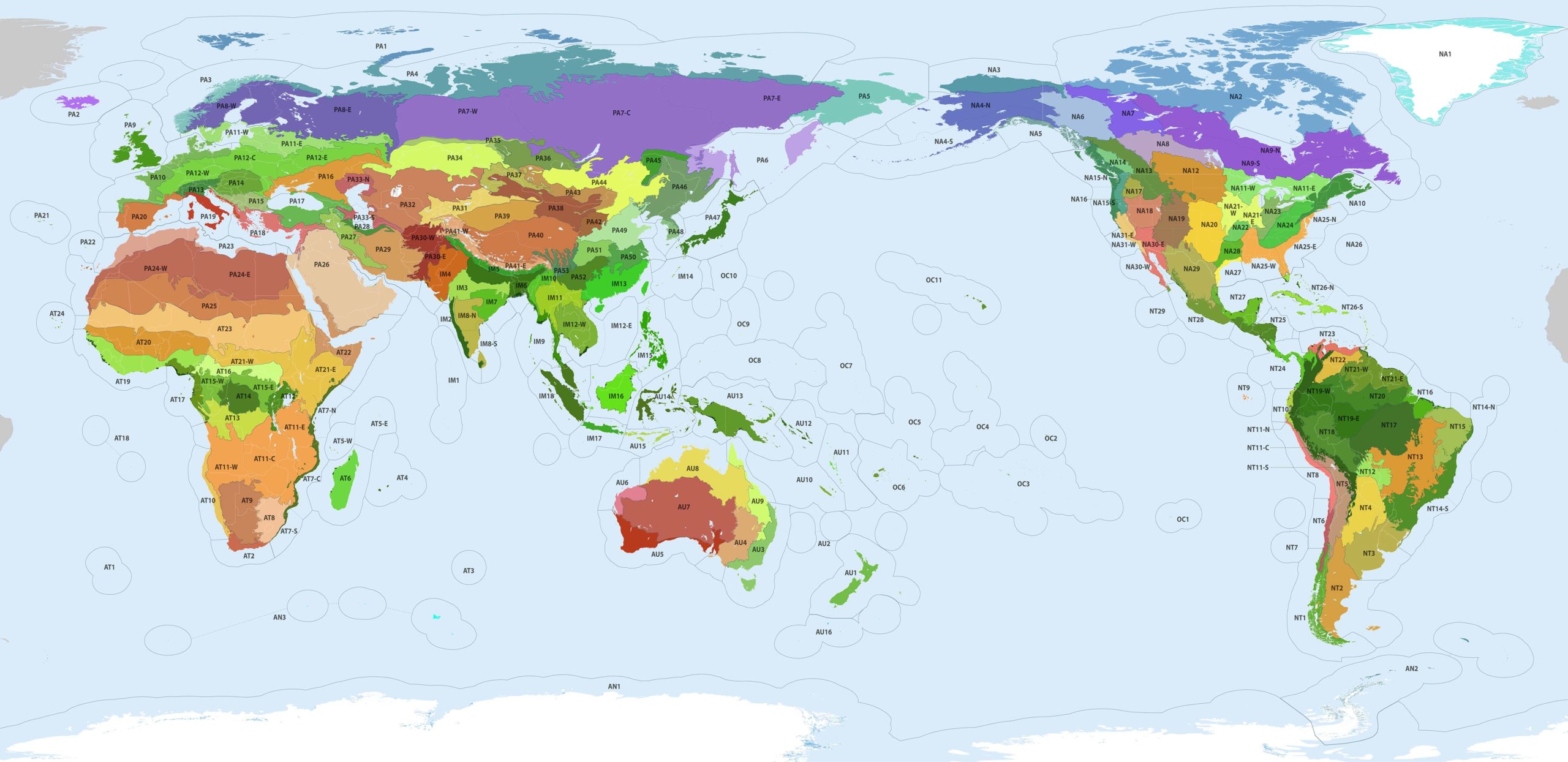
Maps by Karl Burkat. One Earth. (n.d.). Bioregions 2023 | One Earth.
Living labs
Living labs are user-centric environments that serve as laboratories for research and innovation, with a focus on integrating traditional knowledge and emerging technologies. These labs are designed to foster collaboration among diverse stakeholders from different disciplines. The goal is to create a dynamic space where various perspectives come together to address complex challenges and drive innovation.
The CBA(Circular Bioeconomy alliance) Global Network utilizes a landscape restoration project to catalyze the development of circular bioeconomy value chains, concurrently addressing biodiversity restoration and local livelihood improvement. This living lab fosters multidisciplinary collaboration, engaging experts from ecology, economics, and technology. Similarly, the Fablab Network, comprising accessible high-tech workshops, empowers individuals with tools and knowledge for education and innovation in technology and digital fabrication. By ensuring widespread access, the Fablab Network promotes inclusivity and democratizes participation in technology-driven innovation.
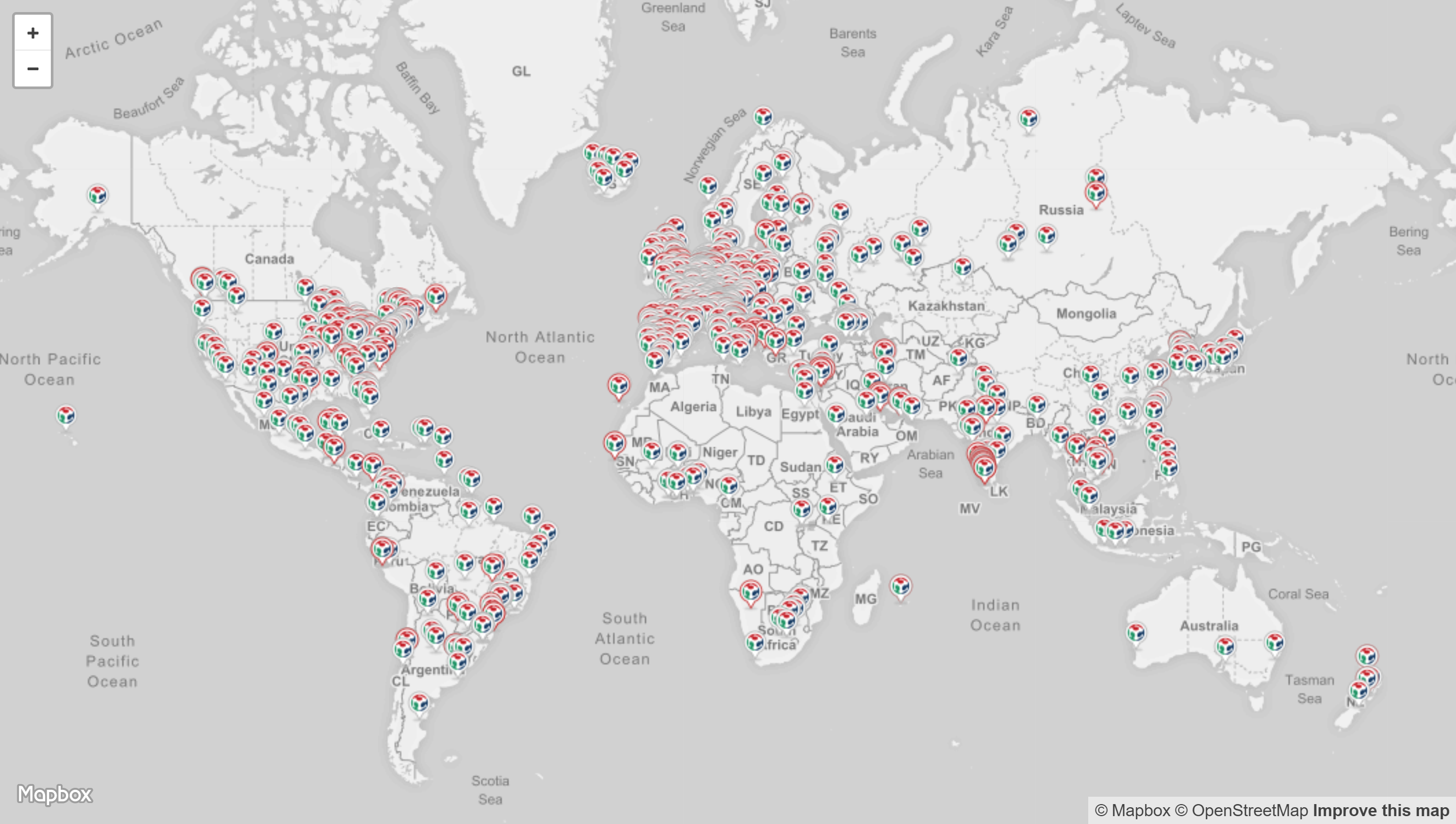
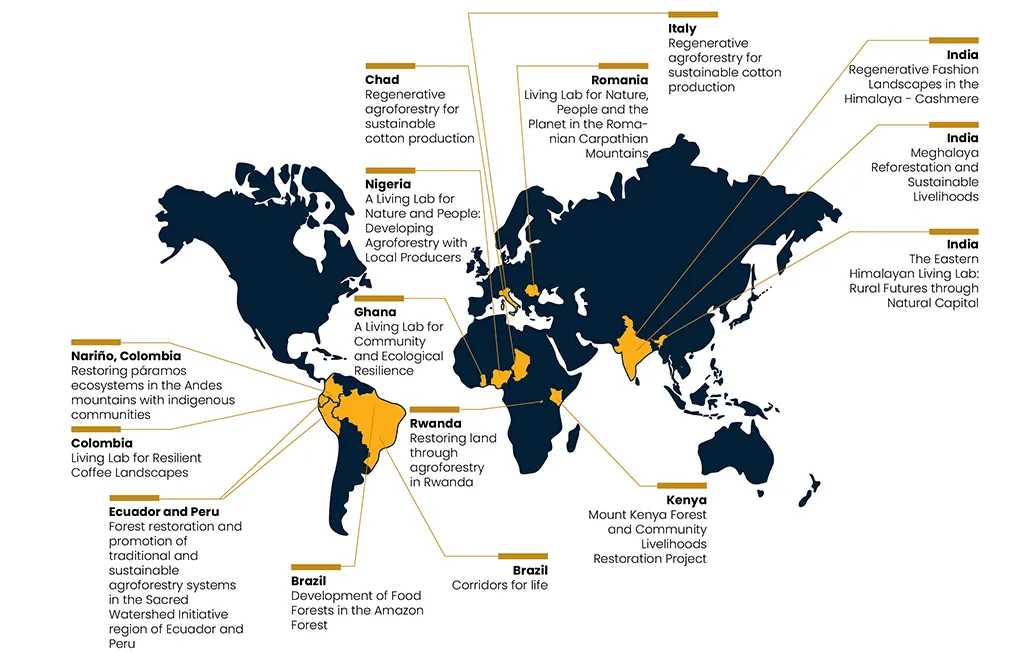
Deforestation
Deforestation refers to the process of clearing, removing, or permanently altering large expanses of forests or wooded areas, typically for agricultural, commercial, or urban development purposes. This process involves the conversion of forested land into non-forest uses, leading to the loss of trees and the ecosystems they support. Deforestation can have significant environmental consequences, including the depletion of biodiversity, disruption of local and global climate patterns, and the release of stored carbon dioxide into the atmosphere, contributing to climate change. The term is often associated with large-scale and unsustainable human activities that result in the substantial and long-term reduction of forested areas.
The primary driver of deforestation is agriculture, propelled by the expanding global population and heightened food demands. Effectively addressing this issue requires vital collaboration between public and private sectors to encourage sustainable food production, taking environmental impacts into account. Additional factors contributing to deforestation encompass logging, human migration, population growth, extractive industries, and urban expansion. Tailored, location-specific solutions are crucial for effectively tackling the diverse causes of deforestation in different regions. The urgency to combat deforestation goes beyond protecting nature and wildlife; it is essential for safeguarding human health and addressing the overarching global climate crisis.
As mass timber gains prominence as a competitive alternative construction material, it becomes crucial to ensure that its increased use does not lead to the depletion of forests under the guise of being a “sustainable” material. Responsible practices are paramount at this juncture, emphasizing the importance of maintaining a proper balance between utilizing natural resources and implementing measures to replenish and contribute back to nature
